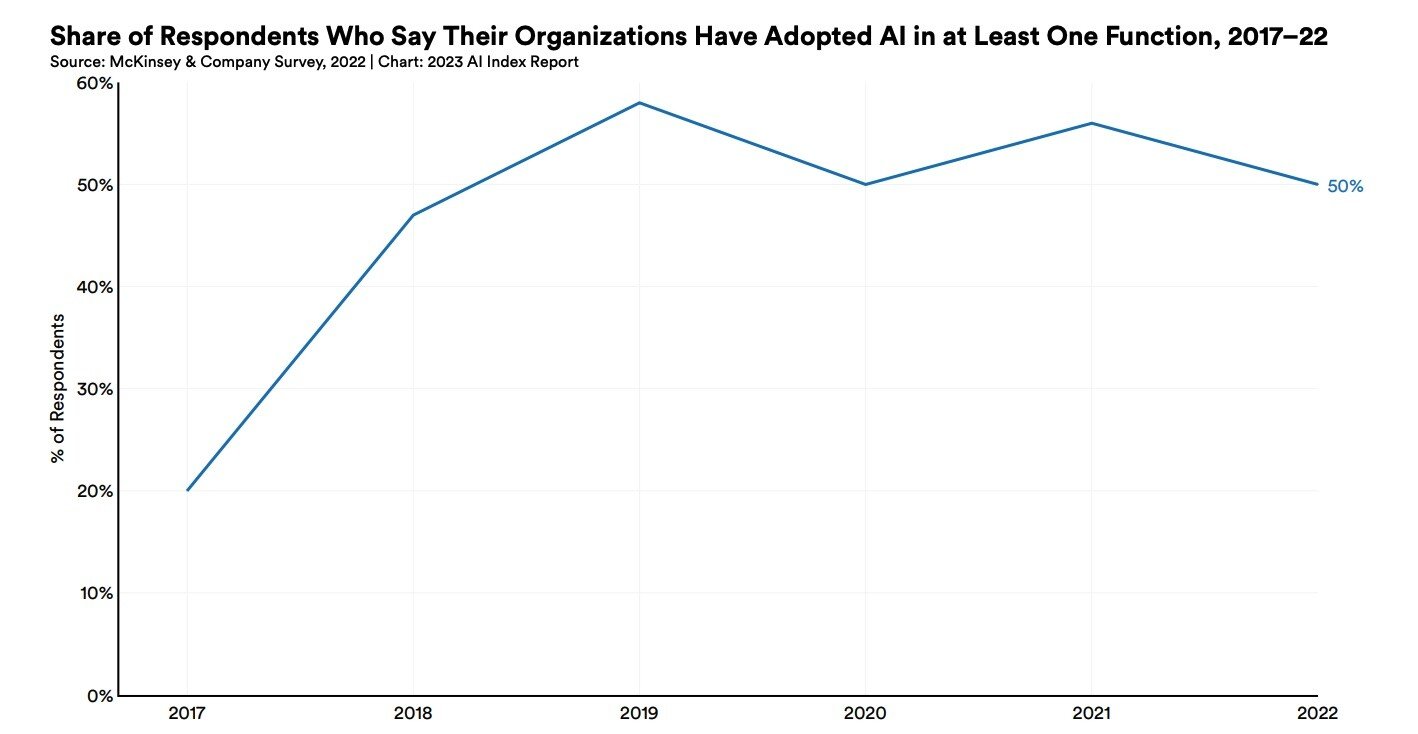The Majority Rule: Rethinking AI Adoption in Business
We’ve found ourselves in the latest AI Spring, with a thousand ‘flowers’ blooming weekly. The pace of funding for startups and new AI solution releases is at an all-time high. Executive boards are feverishly asking leaders, “What are we doing with AI?”
It’s a good question, but for most companies, the answer should be rooted in a long-term strategy, not impulse. Businesses can navigate the challenges of AI adoption by drawing insights from established business frameworks and providing a practical approach for determining when to invest in emerging technologies.
TLDR
Despite the hype around artificial intelligence, only 50% of companies have adopted AI.
Many companies are hesitant to adopt AI despite its potential benefits due to cost, complexity, technical readiness, regulatory uncertainty, and ethical concerns.
AI has a unique ability to have a compounding effect, with rapid increases in performance, and businesses need to understand the ramifications of the speed at which technology advances.
Established companies may struggle to adopt disruptive technologies like AI due to reluctance to disrupt existing business models and risk losing competitive advantage.
Bridging the gap between early adopters and the early majority is crucial for new technologies like AI to achieve mainstream adoption.
We’ve found ourselves in the latest AI Spring, with a thousand ‘flowers’ blooming weekly. The pace of funding for startups and new AI solution releases is at an all-time high. Executive boards are feverishly asking CEOs, “What are we doing with AI?”
It’s a good question, but the answer should be rooted in a long-term strategy, not impulse and fear of missing out.
Why Are Companies Slow to Adopt AI?
Business AI Adoption (McKinsey, 2022)
Companies that have embraced AI and data monetization are seeing substantial benefits from their investment. It transforms how businesses operate, make decisions, and interact with customers. However, despite AI’s immense potential, many companies (50%, according to McKinsey) are still hesitant to adopt this disruptive technology.
"Whenever you find yourself on the side of the majority, it is time to pause and reflect" - Mark Twain
But, as Mark Twain suggests, being part of the majority may not always be the best approach, especially in the rapidly changing landscape of technology. Here are a few key reasons why:
Cost: Implementing AI can be expensive, and smaller companies may need to prioritize their AI initiatives based on budget constraints to ensure sustainable adoption.
Complexity: Integrating AI may add system complexity, technical debt, redundancy, and require process changes, which may require training and buy-in from employees and users.
Technical Readiness: Not all AI technologies are mature or ready for widespread adoption, and careful evaluation of their suitability for specific use cases is necessary before scaling.
Regulatory Uncertainty: The legal and regulatory landscape surrounding AI is complex and constantly evolving, requiring companies to navigate data protection, intellectual property, liability, and transparency requirements to ensure compliance.
Ethical Concerns: Ethical concerns such as bias, privacy, and job displacement associated with AI need to be considered, and ethical and responsible design and implementation of AI systems require careful consideration and due diligence.
Getting Past 'Pause and Reflect'
Pause. Reflect. Move.
No matter how many of the above reasons to cautiously adopt AI are relevant to your organization, you’d be mindful not to sit on the sidelines forever. Face each challenge head-on and evaluate the upside and downside risks in tandem. In today’s fast-paced world, where technology constantly evolves, staying ahead of the curve and finding a path to 'Yes' is crucial for businesses to remain competitive.
AI has shown a unique ability to have a compounding effect, with increases in performance coming at a clip unseen with other technologies. Each iPhone iteration comes yearly, and even Tesla’s industry-disrupting product release cadence has users expecting monthly releases at best. With GPT and other AI capabilities, meaningful progress comes in weeks or days.
Unfortunately, we humble humans have a poor ability to understand compounding effects. We think linearly.
Albert Einstein once described compound interest as the “eighth wonder of the world,” saying, “He who understands it, earns it; he who doesn’t, pays for it.” Unfortunately, too many business leaders fail to understand the ramifications of the speed at which technology advances. Don’t be lulled into inaction because the media coverage doesn’t seem relevant to your business.
Consider that startups can now leverage GPT and related AI technologies to get to market in days at a tenth of the cost of bloated corporations. Sales, marketing, and low-level operations teams are being replaced with AutoGPT digital agents working around the clock to achieve their prompted goals with a vengeance. If you do not have a significant barrier to entry or a moat protecting your revenue stream, be ready for a thousand startups to invade your market.
Disrupt Yourself
The diffusion of innovation theory, developed by Everett Rogers, suggests that technology adoption follows a predictable pattern among different groups of adopters, ranging from innovators and early adopters to the early and late majority and, finally, laggards. While innovators and early adopters are typically eager to embrace new technologies, the majority - comprising of the early and late majority - tends to be more cautious and require more evidence of the value and stability of new technology before adopting it.
When it comes to AI adoption, many businesses fall into the majority category, which can be hesitant to embrace this complex and rapidly evolving technology. This is precisely where Geoffrey Moore’s “Crossing the Chasm” concept becomes relevant. Moore argues that for new technology to achieve mainstream adoption, it needs to bridge the gap, or “chasm,” between the early adopters and the early majority. That leap is only possible when concerns like scalability, reliability, and ease of use are derisked.
“The future is already here – it’s just not evenly distributed.
— William Gibson
Taking Practical Steps Forward
So, how can businesses determine when to invest in emerging technologies like AI? It’s crucial to balance being early adopters and waiting for the right time. Here are some strategies to consider:
Assess business goals: Evaluate your goals, pain points, and long-term strategy in light of emerging competition and capabilities. AI adoption should align with these goals and address existing challenges, such as improving customer experiences, streamlining operations, or enhancing decision-making processes.
Evaluate technological readiness: Before investing in AI, assess your technological readiness across data science, data management, engineering, and operational domains. Do you understand the integration requirements with existing systems, and can you manage production models effectively? If not, find an expert who can.
Build a culture of innovation: Foster a culture of innovation that encourages experimentation, learning, and adaptation. Create cross-functional teams, and empower employees to explore new technologies while rewarding risk-taking and learning from failures.
Partnering with experts: Collaborating with technology experts, consultants, or external partners can provide valuable guidance and support in navigating the complexities of AI adoption. They can help businesses identify optimal use cases, design effective strategies, and ensure successful implementation.
Arm the rebels: Catalyze an army of two-person teams to explore and apply the latest AI releases to reimagine workflows and experiences. Pilot projects to test the viability of AI in specific areas of the business. Before scaling up, you will gather valuable insights, identify challenges, and refine your approach.
Call to Arms
We are at the peak of AI hyperbole (for now), but don’t follow the crowd without thinking for yourself. Don’t blindly pursue AI projects. Instead, pause and reflect on your company’s core value proposition and how AI can help you compound it in a responsible, sustainable, and impactful way. Shift the majority.
Prepare yourself to face short-term limitations and potential risks, but keep in mind the power of recursive acceleration—what’s possible today is a fraction of what you’ll see tomorrow—approach AI with discernment, curiosity, and purpose.
The future is here; cross the chasm and plant your first seed of AI today.







